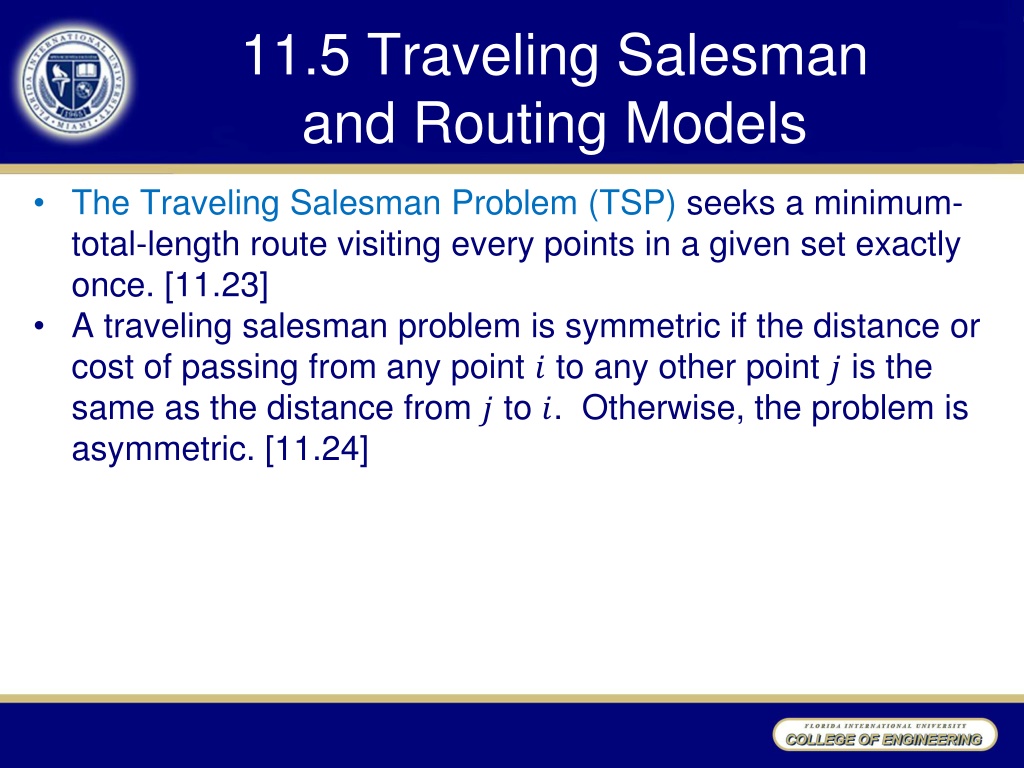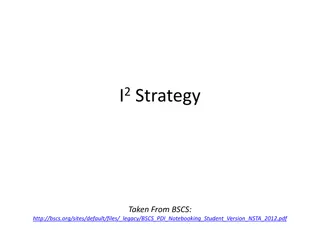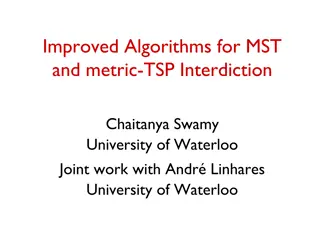Understanding the Traveling Salesman Problem and Its Formulation
The Traveling Salesman Problem (TSP) is a classic optimization problem seeking the shortest route visiting a set of points exactly once. This involves symmetric and asymmetric cases, ILP models, subtours, and quadratic assignment formulations. By employing decision variables and constraints, optimal routes can be calculated efficiently.
Download Presentation

Please find below an Image/Link to download the presentation.
The content on the website is provided AS IS for your information and personal use only. It may not be sold, licensed, or shared on other websites without obtaining consent from the author. Download presentation by click this link. If you encounter any issues during the download, it is possible that the publisher has removed the file from their server.
E N D
Presentation Transcript
11.5 Traveling Salesman and Routing Models The Traveling Salesman Problem (TSP) seeks a minimum- total-length route visiting every points in a given set exactly once. [11.23] A traveling salesman problem is symmetric if the distance or cost of passing from any point ? to any other point ? is the same as the distance from ? to ?. Otherwise, the problem is asymmetric. [11.24]
Example 11.8 NCB Circuit Board TSP Figure 11.4 shows the tiny example that we will investigate for fictional board manufacturer NCB. We seek an optimal route through the 10 hole locations indicated. Table 11.7 reports straight-line distances di,j between hole locations i and j. Lines in Figure 11.4 show a fair quality solution with total length 92.8 inches. The best route is 11 inches shorter (see Section 12.6). 1 2 1 3.6 2 3.6 3 5.1 3.6 4 10.0 6.4 5 15.3 12.1 10.6 6 20.0 18.1 15.0 15.7 7 16.0 13.2 15.8 10.0 15.3 25.0 8 14.2 10.6 10.8 9 23.0 19.7 18.4 13.9 10 26.4 23.0 21.9 17.0 11.3 15.0 21.0 13.0 3 5.1 10.0 15.3 20.0 16.0 14.2 23.0 26.4 3.6 6.4 12.1 18.1 13.2 10.6 19.7 23.0 7.1 10.6 15.0 15.8 10.8 18.4 21.9 7.1 7.0 15.7 10.0 7.0 9.9 15.3 9.9 4 5 6 7 8 9 10 1 3 6 2 4.2 13.9 17.0 5.0 7.8 11.3 25.0 14.9 12.0 15.0 10.3 19.2 21.0 5.0 14.9 10.3 7.8 12.0 19.2 10.2 4 5 9 4.2 10.2 13.0 8 10 3.6 7 3.6
Formulating the Symmetric TSP Most ILP models of the symmetric case employ decision variables, ? < ? ??,? 1 if the route includes a leg between i and j 0 otherwise Total length of a route can be calculated by (11.15) ??,???,? ? ?>? Constraints for symmetric TSP (11.16) ??,?+ ??,?= 2 ??? ??? ? ?<? ?>?
Subtours Definition of subtours S proper subset of points/cities to be routed Subtour elimination constraints 1 3 6 2 ??,?+ ??,? 2 4 (11.17) 5 ? ? ? ? ? ? ? ? Number of legs between points in S and points not in S must be at least 2. 9 8 7 10
ILP Model of the Symmetric TSP min ??,???,? ? ?>? s.t. ??,?+ ??,?= 2 ??? ??? ? ?<? ?>? ??,?+ ??,? 2 ??? ??? ?, ? 3 ? ? ??,?= 0 ?? 1 ??? ??? ?,? > ? ? ? ? ? ? ? [11.25]
ILP Model of the Asymmetric TSP min ??,???,? ? ? ? s.t. ??,?= 1 ??? ??? ? ? ??,?= 1 ??? ??? ? ? [11.26] ??,? 1 ??? ??? ?, ? 2 ? ? ??,?= 0 ?? 1 ??? ??? ?,? ? ?
Quadratic Assignment Formulation of the TSP ??,? 1 if kth point visited is i 0 otherwise Let [11.27] min ??,? ??,???+1,? (Total length) s.t. ? ? ? ??,?= 1 ??? ??? ? (each position occupied) ? ??,?= 1 ??? ??? ? (each point visited) ? ??,?= 0 ?? 1 ??? ??? ?,?
Example 11.9 KI Truck Routing Kraft Incorporated confronts such multiple-route design problems in planning truck delivery of its food products to over 100,000 commercial, industrial, and military customers in North America. Known customer requirements must be grouped into truckloads and then routes planned. Our tiny fictitious version of the KI case has 20 stops to be serviced from a single depot. 1 2 5 11 fi fi Stop, i Stop, i 7 3 9 10 8 1 2 3 4 5 6 7 8 9 10 11 12 13 14 15 16 17 18 19 20 0.25 0.33 0.39 0.40 0.27 0.70 0.28 0.43 0.50 0.22 0.21 0.68 0.16 0.19 0.22 0.38 0.26 0.29 0.17 0.31 4 6 12 19 18 16 13 14 17 15 20
Example 11.9 KI Truck Routing 7 3 1 9 8 2 10 5 11 4 6 12 19 18 16 13 14 17 15 20
KI Truck Routing Example Model ??,? 1 if stop i is assigned to route j 0 otherwise 7 Let (11.18) min ??(?) s.t. ?=1 7 ??,?= 1 ??? ??? ? = 1, ,20 (each i to some j) ?=1 20 ????,? 1 ??? ??? ? = 1, ,7 (truck capacities) ?=1 ??,?= 0 ?? 1 ??? ??? ?,?
KI Truck Routing Example Model ??(?) length of the best route through stops assigned to truck j by decision vector z z Routing problems are characteristically difficult to represent concisely in optimization models. [11.28]
11.6 Facility Location and Network Design Models Fixed charges can be modeled with new binary variables and switching constraints. Facility Location and Network Design are common cases of fixed charges. Facility Location Models Facility/plant/warehouse location models choose which of a proposed list of facilities to open in order to service specified customer demands at minimum total cost. [11.29]
Example 11.10 Tmark Facilities Location AT&T has confronted many facility location problems in recommending sites for the toll-free call-in centers of its telemarketing customers. Such centers handle telephone reservations and orders arising in many geographic zones. Since telephone rates vary dramatically depending on the zone of call origin and the location of the receiving center, site selection is extremely important. A well-designed system should minimize the total of call charges and center setup costs. Our version of this scenario will involve fictional firm Tmark. Figure 11.7 shows the 8 sites under consideration for Tmark s catalog order centers embedded in a map of the 14 calling zones. Table 11.9 shows corresponding unit calling charges, ri,j, from each zone j to various centers i, and the zone s anticipated call load, dj. Any Tmark center selected can handle between 1500 and 5000 call units per day. However, their fixed costs of operation vary significantly because of differences in labor and real estate prices. Estimated daily fixed cost, fi, for the 8 centers are displayed in Figure 11.7.
Example 11.10 Tmark Facilities Location Fixed Cost 2400 7000 3600 1600 3000 4600 9000 2000 i 1 2 3 4 5 6 7 8 4 6 7 1 5 2 3 8
Example 11.10 Tmark Facilities Location Zone j 1 2 3 4 5 6 7 8 9 10 11 12 13 14 Possible Center Location, i 3 4 1.10 0.90 0.90 1.30 0.80 1.70 1.40 0.50 0.60 0.70 1.10 0.60 1.25 0.80 1.00 1.10 1.70 1.30 1.30 1.50 2.40 1.90 2.20 1.80 1.90 1.90 2.00 2.20 Call 1 2 5 6 7 8 Demand 250 150 1000 80 50 800 325 100 475 220 900 1500 430 200 1.25 0.80 0.70 0.90 0.80 1.10 1.40 1.30 1.50 1.35 2.10 1.80 1.60 2.00 1.40 0.90 0.40 1.20 0.70 1.70 1.40 1.50 1.90 1.60 2.90 2.60 2.00 2.40 1.50 1.40 1.60 1.55 1.45 0.90 0.80 0.70 0.40 1.00 1.10 0.95 1.40 1.50 1.90 2.20 2.50 1.70 1.80 1.30 1.00 1.50 0.80 1.20 2.00 0.50 1.00 1.20 2.00 2.10 2.05 1.80 1.70 1.30 1.00 1.50 0.70 1.10 0.80 2.00 0.90 1.10 2.10 1.80 1.60 1.40 1.30 1.40 1.10 1.00 0.80 0.70 1.20 1.00 0.80 0.80
ILP Model of Facilities Location ?? 1 if facility i is open 0 otherwise Let ??,? fraction of demand j fulfilled from facility i min ??,?????,?+ ???? [11.30] s.t. ? ? ? ??,?= 1 ??? ??? ? (??????? ? ??????) ? ????,? ???? ??? ??? ? (? ???????? ????? ???) ? ??,? 0 ??? ??? ?,? ??= 0 ?? 1 ??? ??? ?
Tmark Facilities Location Example Model 8 14 8 (11.20) ??? (??,???)??,?+ ???? ?=1 ?=1 ?=1 8 s.t. ??,?= 1 ??? ??? ? (????? ? ????) ?=1 14 1500?? ????,? 5000?? (???????? ?? ?) ?=1 ??,? 0 ??? ??? ?,? ??= 0 ?? 1 ??? ??? ?
Network Design Models The fixed-charge network flow or network design model on a digraph on nodes k V with net demand bk, and arcs (i,j) A with capacity ui,j, unit cost ci,j, and non-negative fixed cost fi,j is [11.31] s.t. ??? ??,???,?+ ??,???,? (?,?) ? (?,?) ? ??,? ??,?= ?? ??? ??? ? ? (?,?) ? 0 ??,? ??,???,? ??? ??? (?,?) ? ??,?= 0 ?? 1 ??? ??? (?,?) ? ?,? ?
Example 11.11 Wastewater Network Design Network design applications may involve telecommunications, electricity, water, gas, coal slurry, or any other substance that flows in a network. We illustrate with an application involving regional wastewater (sewer) networks. As new areas develop around major cities, entire networks of collector sewers and treatment plants must be constructed to service growing population. Figure 11.8 displays our particular (fictional) instance. Nodes 1 to 8 of the network represent population centers where smaller sewers feed into the main regional network, and locations where treatment plants might be built. Wastewater loads are roughly proportional to population, so the inflows indicated at nodes represent population units (in thousands).
Example 11.11 Wastewater Network Design Arcs joining nodes 1 to 8 show possible routes for main collector sewers. Most follow the topology in gravity flow, but one pumped line (4. 3) is included. A large part of the construction cost for either type of line is fixed: right-of-way acquisition, trenching, and so on. Still, the cost of a line also grows with the number of population units carried, because greater flows imply larger-diameter pipes. The table in Figure 11.8 shows the fixed and variable cost for each arc in thousand of dollars. Treatment plant costs actually occur at nodes here nodes 3, 7, and 8. Figure 11.8 illustrates, however, that such costs can be modeled on arcs by introducing an artificial supersink" node 9. Costs shown for arcs (3, 9), (7. 9), and (8, 9) capture the fixed and variable expense of plant construction as flows depart the network.
Example 11.11 Wastewater Network Design Arc (1,2) (1,3) (2,3) (2,4) (3,4) (3,9) (4,3) (4,8) (5,6) (5,7) (6,7) (6,8) (7,4) (7,9) (8,9) Fixed Cost 240 350 200 750 610 3800 1840 780 620 800 500 630 1120 3800 2500 Var. Cost 21 30 22 58 43 1 49 63 44 51 56 94 82 1 2 3 2 1 27 14 3 4 36 13 7 21 5 6 8 9 gravity pumped plant arcs 8
Wastewater Network Design Example Model min 21x1,2+30x1,3 +22x2,3+58x2,4 +43x3,4+ x3,9 +49x4,3+63x4,8 +44x5,6 +51x5,7+56x6,7 +94x6,8 +82x7,4+x7,9 +2x8,9+240y1,2 +350y1,3 +200y2,3+750y2,4 +610y3,4+ 3800y3,9 +1840y4,3 +780y4,8 +620y5,6 +800y5,7+500y6,7 +630y6,8 +1120y7,4 +3800y7,9 +2500y8,9 s.t. x1,2 x1,3 = -27 x1,2 x2,3 5x2,4 = -3 x1,3 + x2,3 + x4,3 x3,4 x3,9 = -14 x2,4 + x3,4 + x7,4 x4,3 x4,8 = -36 x5,6 x5,7 = -21 x5,6 x6,7 x6,8 = -8 x5,7 + x6,7 x7,4 x7,9 = -13 x4,8 + x6,8 x8,9 = 0 x3,9 + x7,9 + x8,9 = 122 yi,j = 0 or 1 all arcs (i,j) 0 x1,2 27y1,2 0 x1,3 27y1,3 0 x2,3 30y2,3 0 x2,4 30y2,4 0 x3,4 44y3,4 0 x3,9 122y3,9 0 x4,3 108y4,3 0 x4,8 122y4,8 0 x5,6 21y5,6 0 x5,7 21y5,7 0 x6,7 29y6,7 0 x6,8 29y6,8 0 x7,4 42y7,4 0 x7,9 42y7,9 0 x8,9 122y8,9
11.7 Processor Scheduling and Sequencing Models Single-Processor Scheduling Problems Single-processor (or single-machine) scheduling problems seek an optimal sequence in which to complete a given collection of jobs on a single processor that can accommodate only one job at a time. [11.32]
Example 11.12 Nifty Notes Single-Machine Scheduling We begin with the binder scheduling problem confronting a fictitious Nifty Notes copy shop. Just before the start of each semester, professors at the nearby university supply Nifty Notes with a single original of their class handouts, a projection of the class enrollment, and a due date by which copies should be available. Then the Nifty Notes staff must rush to print and bind the required number of copies before each class begins. During the busy period each semester, Nifty Notes operates its single binding station 24 hours per day. Table 11.10 shows process times, release times, and due dates for the jobs j = 1,..., 6 now pending at the binder.: We wish to choose an optimal sequence in which to accomplish these jobs. No more than one can be in process at a time; and once started. a job must be completed before another can begin.
Example 11.12 Nifty Notes Single-Machine Scheduling pj estimated process time (in hours) job j will require to bind rj release time (hour) at which job j has/will become available for processing (relative to time 0 = now) dj = due date (hour) by which job j should be completed (relative to time 0 = now) Notice that two jobs are already late (dj < 0). Binder Job, j 3 3 -12 72 1 12 -20 10 2 8 4 10 -10 -8 5 4 -3 -6 6 18 2 60 Process time, pj Release time, rj Due date, dj -15 2
Time Decision Variables A set of (continuous) decision variables in processor scheduling models usually determines either the start or the completion time(s) of each job on the processor(s) it requires. [11.33] xj time binding starts for job j (relative to time 0 = now) Constraints on the starting time: xj max {0, rj} Completion time: (Start time) + (Process time) = (Completion time) (11.22)
Conflict Constraints and Disjunctive Variables The central issue in processor scheduling is that only one job should be in progress on any processor at any time. For a pair of jobs j and j that might conflict on a processor, the appropriate conflict constraint is either (11.23) (start time of j) + (process time of j) (start time of j ), or (start time of j ) + (process time of j ) (start time of j) Conflict avoidance requirement can be modeled explicitly with the aid of additional disjunctive variables. A set of (discrete) disjunctive variables in processor scheduling models usually determines the sequence in which jobs are started on processors by specifying whether each job j is scheduled before or after each other j with which it might conflict. [11.34]
Conflict Constraints and Disjunctive Variables A processor scheduling model with job start time xj and process time pjcan prevent conflicts between jobs j and j with disjunctive constraint pairs xj + pj xj + M(1 yj,j ) xj + pj xj + Myj,j Where M is a large positive constant, and binary disjunctive variable yj,j =1when j is schedule before j on the processor and =0 if j is first. [11.35]
Handling of Due Dates Due dates in processor scheduling models are usually handled as goals to be reflected in the objective function rather than as explicit constraints. Dates that must be met are termed deadlines to distinguish. [11.36]
Processor Scheduling Objective Functions Denoting the start time of job j=1, , n by xj, the process time by pj, the release time by rj and the due date by dj, processor scheduling objective functions often minimize one of the following: [11.37] Maximum completion time (makespan) Mean completion time (makespan) Maximum flow time maxj{xj + pj - rj} Mean flow time (1/n) j(xj + pj - rj) Maximum lateness Mean lateness Maximum tardiness maxj{max[0, xj + pj dj]} Mean tardiness (1/n) j(max{0, xj + pj dj}) maxj{xj + pj} (1/n) j(xj + pj) maxj{xj + pj - dj} (1/n) j(xj + pj - dj)
ILP Formulation of Minmax Scheduling Objective When any of the minmax objective are being optimized, the problem is an integer non-linear program (INLP). Any of the min max objectives can be linearized by introducing a new decision variable f to represent the objective function value, then minimizing f subject to new constraints of the form f each element in the maximize set. A similar construction can model tardiness by introducing new non-negative tardiness variables for each job and adding constraints keeping each tardiness variable the corresponding lateness. [11.38]
Equivalences among Scheduling Objective Functions The mean completion time, mean flow time, and mean lateness scheduling objective functions are equivalent in the sense that an optimal schedule for one is also optimal for the others. [11.39] An optimal schedule for the maximum lateness objective function is also optimal for maximum tardiness. [11.40]
Job Shop Scheduling Job shop scheduling problems seek an optimal schedule for a given collection of jobs, each of which requires a known sequence of processors that can accommodate only one job at a time. [11.41]
Example 11.13 Custom Metalworking Job Shop We illustrate job shop scheduling with a fictitious Custom Metalworking company which fabricates prototype metal parts for a nearby engine manufacturer. Figure 11.9 provides details on the 3 jobs waiting to be scheduled. First is a die requiring work on a sequence of 5 workstations: 1 (forging), then 2 (machining), then 3 (grinding), then 4 (polishing), and finally, 6 (electric discharge cutting). Job 2 is a cam shaft requiring 4 stations, and job 3 a fuel injector requiring 5 steps. Numbers in boxes indicate process times Pj,k process time (in minutes) of job j on processor k For example, job 1 requires 45 minutes at polishing workstation 4. Any of the objective function forms in [11.37] could be appropriate for Custom Metalworking s scheduling. We will assume that the company wants to complete all 3 jobs as soon as possible (minimize maximum completion), so that workers can leave for a holiday.
Example 11.13 Custom Metalworking Job Shop k 1 2 Workstations Forging Machining center Grinding Polishing Drilling Electric discharge Heat treatment WS1 3 WS4 45 WS3 8 WS2 10 WS6 1 1. Die 3 4 5 6 WS2 11 WS1 6 WS7 50 WS3 6 2. Camshaft WS2 5 WS6 1 WS5 2 WS3 9 WS4 25 3. Fuel Injector 7
Custom Metalworking Example Decision Variables and Objective Decision variables ??,k start time of job j on processor k Objective function min max {x1,6+1, x2,3+6, x3,4+25} Precedence constraints The precedence requirement that job j must complete on processor k before activity on k begins can be expressed as xj,k + pj,k xj,k where xj,k denotes the start time of job j on processor k, pj,k is the process time of j on k, and xj,k is the start time of job j on processor k . [11.42]
Custom Metalworking Example Decision Variables and Objective ??,? ,? 1 if j is scheduled before job j on processor k 0 otherwise Job shop models can prevent conflicts between jobs by introducing new disjunctive variables yj,j ,k and constraint pair xj,k + pj,k xj,k + M (1 - yj,j ,k ) xj ,k + pj ,k xj,k + M yj,j ,k ) For each j, j that both require any processor k. Here xj,k denotes the start time of job j on processor k, pj,k is the process time, M is a large positive constant, and binary yj,j ,k=1 when j is scheduled before j on k, and =0 if j is first. [11.43]
Custom Metalworking Example Model min max {x1,6+1, x2,3+6, x3,4+25} s.t. x1,1 +3 x1,2 x1,2 +10 x1,3 x1,3 +8 x1,4 x1,4 +45 x1,6 x2,7 +50 x2,1 x2,1 +6 x2,2 x2,2 +11 x2,3 x3,2 +5 x3,3 x3,3 +9 x3,5 x3,5 +2 x3,6 x3,6 +1 x3,4 x1,3 +8 x3,3 +M(1-y1,3,3) x3,3 +9 x1,3 +My1,3,3) x1,1 +3 x2,1+M(1-y1,2,1) x2,1 +6 x1,1+My1,2,1 x1,2 +10 x2,2 +M(1-y1,2,2) x2,2 +11 x1,2 +My1,2,2 x1,2 +10 x3,2 +M(1-y1,3,2) x3,2 +5 x1,2 +My1,3,2 x2,2 +11 x3,2 +M(1-y2,3,2) x3,2 +5 x1,2 +My2,3,2) x1,3 +8 x2,3 +M(1-y1,2,3) x2,3 +6 x1,3 +My1,2,3) x2,3 +6 x3,3+M(1-y2,3,3) x3,3 +9 x2,3+My2,3,3 x1,4 +45 x3,4 +M(1-y1,3,4) x3,4 +25 x1,4 +My1,3,4 x1,6 +1 x3,6 +M(1-y1,3,6) x3,6 +1 x1,6 +My1,3,6 xj,k 0 yj,j ,k= 0 or 1























